Building guitars for a living and having
a reputation as one of the best luthiers
in the boutique category would probably be
a dream scenario for most admirers of the
guitar. How about having your shop 4,000
feet up Mt. Haleakala on the island of Maui?
As a woodworker and working musician,
Steve Grimes was fascinated by the prospect
of combining the two professions and began
building guitars in the early ’70s. Now with
almost 40 years of building high-end archtops,
flattops, mandolins, and ukes, Grimes
has amassed an impressive client list which
includes such luminaries as George Benson,
Walter Becker, Steve Miller, and Willie
Nelson, to name a few.
While Grimes does have a large selection
of standard model instruments, he specializes
in custom tailoring one-off guitars to suit the
tonal, aesthetic, and playability requirements
of his customers. When asked about one of
his more interesting custom requests, Grimes
recalled the “Family Tree” guitar he built for
a well-known collector. A double-soundhole,
flattop guitar, Grimes designed a fretboard
with a tree of life inlay, but instead of flowers
in the vine he made highly detailed engravings
of the faces of the customer’s family.
From the grandfather on down to a four-year-
old daughter, Grimes succeeded in capturing
the expressions so well that the young
girl recognized all the family members.
Grimes Guitars is a relatively small shop
with only one other luthier on staff. The
instruments are produced slowly and meticulously
by hand with just about 20 created
each year. Grimes builds a few guitars at a
time from start to finish, believing that he is
better able to control the response and tonal
characteristics as each instrument progresses.
When questioned about what present
trend in luthiery would have a major effect
20 years from now, Grimes says, “I think
that the current trend toward mechanization
and computerization will continue to
evolve, yielding guitars with high quality
and lower prices.” He continued, “But I
think we are still a long way off from having
a computer being able to discern good
wood from bad, voicing guitars depending
on the stiffness of wood, and catering to the
specific tonal and aesthetic needs of players
looking for something special. I expect I’ll
still be taking custom orders in 30 years.”
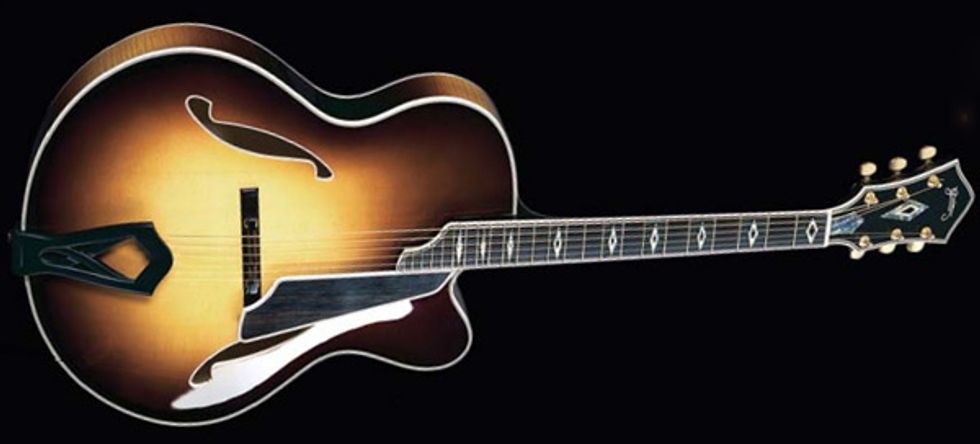
Jazz Laureate
The woods used for the Jazz Laureate—available in cutaway and non-cutaway—are selected from hundreds of samples of master grade wood for their exceptional tonal characteristics and visual beauty. The backs and sides are cut from the same billet of old cello wood, ensuring visual and tonal continuity, and Grimes personally chooses and tests this wood for lightness, stiffness, sustain, and purity of tone. Appointments include five-ply wood purflings with an optional dyed wood strip in the center of the five plies, and wood bindings consisting of curly koa, rosewood, silkwood, curly maple, or African blackwood. Inlays include a multi-layered diamond consisting of alternating strips of paua shell abalone from New Zealand and mother-of-pearl.
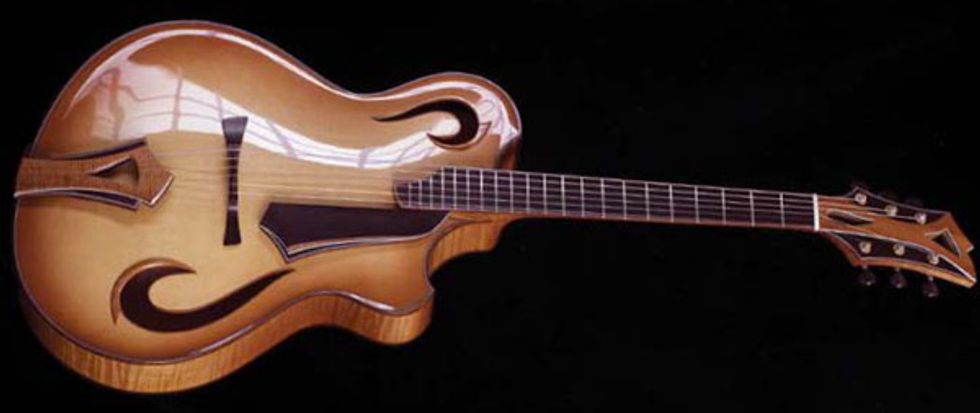
Pescatore
This custom guitar, called the Pescatore, features soundholes that resemble fishhooks in the ancient Hawaiian design. Needless to say, it was built for a customer that loves to fish. The Pescatore is a departure from Grimes’ more traditional archtops in a few ways. For one, the body is not symmetrical, and it features two points in the upper bout. The location of the two soundholes imparts a unique tone since there is more room on the bass side between the bridge and the widest part of the body, and a larger area from neck to tail for the bass tones to develop. The bridge is 100 percent ebony with no metal studs or adjusting wheels, allowing the bridge to be 75 percent of the weight of a traditional archtop bridge. A lighter bridge has less damping effect on the overall tone and volume. The action is adjusted by loosening the strings and simply sliding in a slightly lower or higher saddle.
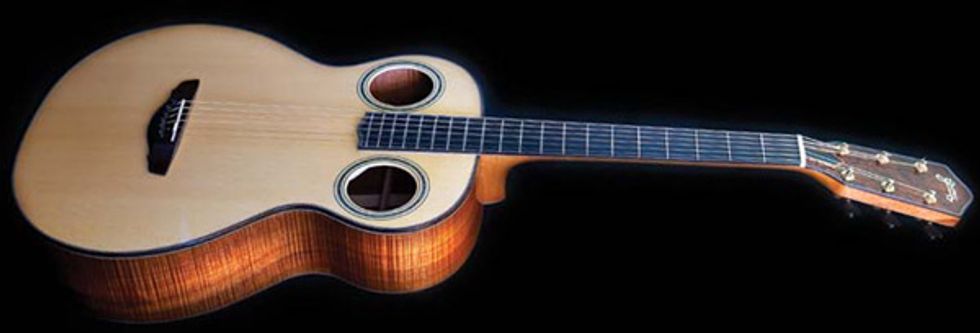
The Beamer Steel String
This double soundhole guitar was originally designed for and made popular by acclaimed Hawaiian slack key artist Keola Beamer. By moving the soundhole away from the traditional spot at the end of the fretboard, a larger area of the top can be utilized to achieve a bigger sound overall. Grimes likens the difference between one traditional 3 7/8" and two 2 7/8" soundholes to the bass richness of a 15" woofer compared to a 10" woofer on a stereo system. Available in OM (15 1/8" wide) and Concert (16" wide) sizes, the Beamer is offered with an Engelmann or Sitka spruce top and the choice of koa, mahogany, Indian rosewood, maple, or walnut for the back and sides.
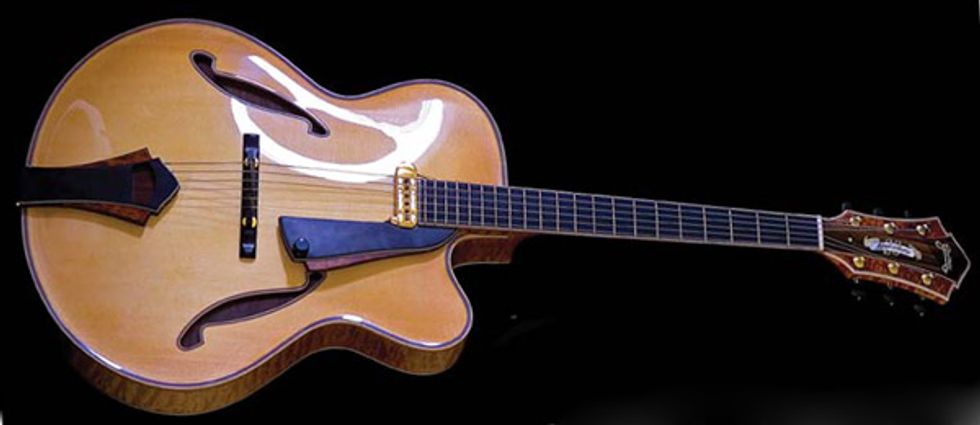
25th Anniversary Koa Edition
1999 was Grimes’ 25th year of producing archtop instruments. To commemorate the milestone, he designed an archtop guitar that originally was intended to be a limited edition guitar. The design proved to be so popular that he’s still taking orders for this model. Only the most special sets of wood Grimes has acquired over the years are used to construct the 25th Anniversary Model guitars, and they all feature wooden binding and purfling with maple, rosewood, African blackwood, ebony, bloodwood, or curly koa. Available in 16", 16.5", 17", and 18" sizes, the pictured guitar is finished in Light Parchment and is loaded with an optional DeArmond Rhythm Chief 1100 pickup.
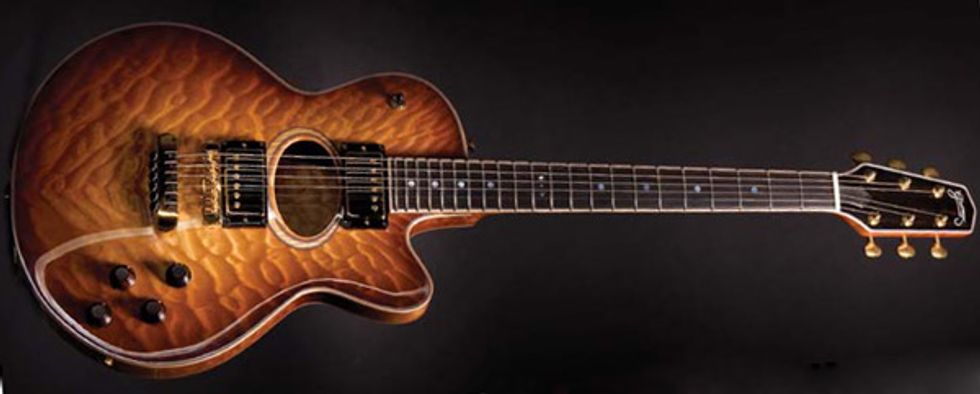
Bird of Paradise
The Bird of Paradise model is a semi-solidbody electric guitar that features carved, curly maple top and back plates with a Honduras mahogany core. The body is 60 percent solid, providing excellent sustain without the unnecessary weight of a solidbody and the feedback problems inherent in many acoustic-electrics. Designed with excellent balance in mind and weighing approximately 7.5 pounds, it is comfortable to hold for longer periods of time. Sporting an oval soundhole, the pickups and electronics are per customer’s specifications. This particular Bird of Paradise is outfitted with a pair of Seymour Duncan Seth Lovers.
Pricing and Availability
The approximate waiting period for a Grimes guitar is currently 18 months or more, depending on the order. Pricing varies per model, from $9200 for the Bird of Paradise to $18,500 for the 25th Anniversary to $22,000 for the Pescatore. With a variety of add-ons and options, the sky is certainly the limit.
grimesguitars.com







![Rig Rundown: Russian Circles’ Mike Sullivan [2025]](https://www.premierguitar.com/media-library/youtube.jpg?id=62303631&width=1245&height=700&quality=70&coordinates=0%2C0%2C0%2C0)


























